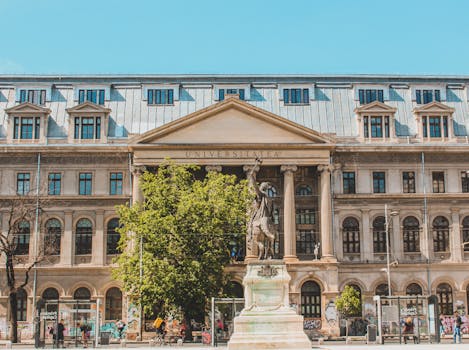
Traveling Through Time: How Europe’s Historical Heritage Shapes Modern Lifestyles in 2025
Traveling Through Time: How Europe’s Historical Heritage Shapes Modern Lifestyles in 2025. Europe, with its vast and diverse history, has always been a hub of cultural and artistic expression. From the Roman Empire to the Renaissance, Europe’s historical heritage has played a significant role in shaping the continent’s modern lifestyles. In this article, we will explore how Europe’s rich history continues to influence modern lifestyles in 2025, from architecture to art and cuisine.
Introduction to Europe’s Historical Heritage
Europe’s historical heritage is a treasure trove of cultural and artistic expression, with a history that spans thousands of years. From the ancient Greeks and Romans to the modern era, Europe has been a hub of innovation, creativity, and progress. The continent’s historical heritage is reflected in its architecture, art, literature, music, and cuisine, making it a unique and fascinating place to explore.
The Influence of Historical Heritage on Modern Lifestyles
The influence of historical heritage on modern lifestyles in Europe is evident in many aspects of daily life. For example, the continent’s architectural heritage, including iconic landmarks such as the Eiffel Tower and the Colosseum, continues to inspire modern building designs. The art world is also heavily influenced by historical heritage, with many modern artists drawing inspiration from the works of European masters such as Leonardo da Vinci and Vincent van Gogh.
Preserving Historical Heritage for Future Generations
Preserving historical heritage for future generations is essential to maintaining the cultural and artistic identity of Europe. Governments, organizations, and individuals are working together to protect and conserve historical sites, monuments, and artifacts, ensuring that they remain accessible and enjoyable for years to come. This includes initiatives such as restoration projects, cultural events, and educational programs, all of which help to promote the importance of historical heritage and its impact on modern lifestyles.
Conclusion
In conclusion, Europe’s historical heritage plays a significant role in shaping modern lifestyles in 2025. From architecture to art and cuisine, the continent’s rich history continues to inspire and influence contemporary culture. By preserving and promoting historical heritage, we can ensure that future generations continue to appreciate and learn from the past, while also embracing the innovations and advancements of the present.
Modern Lifestyles in Europe
Modern lifestyles in Europe are a unique blend of traditional and contemporary elements. The continent’s historical heritage is evident in its vibrant cities, where ancient architecture and modern design coexist in harmony. From the fashion capital of Paris to the culinary delights of Italy, Europe offers a diverse and exciting range of experiences that reflect its rich cultural and artistic heritage.
Cultural Events and Festivals
Cultural events and festivals are an integral part of modern lifestyles in Europe, showcasing the continent’s historical heritage and its impact on contemporary culture. From the Venice Carnival to the Tomatina festival in Spain, these events bring people together, celebrating the region’s unique traditions and customs. They also provide a platform for artists, musicians, and performers to showcase their talents, adding to the rich cultural tapestry of Europe.
Food and Cuisine
Food and cuisine are essential aspects of modern lifestyles in Europe, reflecting the continent’s historical heritage and its cultural diversity. From traditional dishes such as pasta and pizza to modern fusion cuisine, European food is a delicious and exciting reflection of its rich history. The continent’s famous wine regions, such as Bordeaux and Tuscany, also offer a glimpse into the region’s historical heritage, with many vineyards dating back centuries.
Travel and Tourism
Travel and tourism are significant contributors to modern lifestyles in Europe, with the continent’s historical heritage being a major draw for visitors. From the iconic landmarks of Paris and Rome to the scenic landscapes of the Scottish Highlands, Europe offers a wealth of exciting and educational experiences. By exploring the continent’s historical heritage, travelers can gain a deeper understanding of its cultural and artistic significance, while also contributing to the local economy and helping to preserve historical sites and monuments.
Education and Research
Education and research are essential components of modern lifestyles in Europe, with the continent’s historical heritage playing a significant role in shaping academic and intellectual pursuits. From the ancient universities of Oxford and Cambridge to the modern institutions of today, Europe’s historical heritage is reflected in its educational systems and research initiatives. By studying the continent’s history and cultural heritage, students and scholars can gain a deeper understanding of the complex issues and challenges facing modern society.
Conclusion
In conclusion, Traveling Through Time: How Europe’s Historical Heritage Shapes Modern Lifestyles in 2025 is a fascinating and complex topic that reflects the continent’s rich cultural and artistic heritage. From architecture to art and cuisine, historical heritage continues to influence and inspire modern lifestyles in Europe, making it a unique and exciting place to explore. By preserving and promoting historical heritage, we can ensure that future generations continue to appreciate and learn from the past, while also embracing the innovations and advancements of the present.




